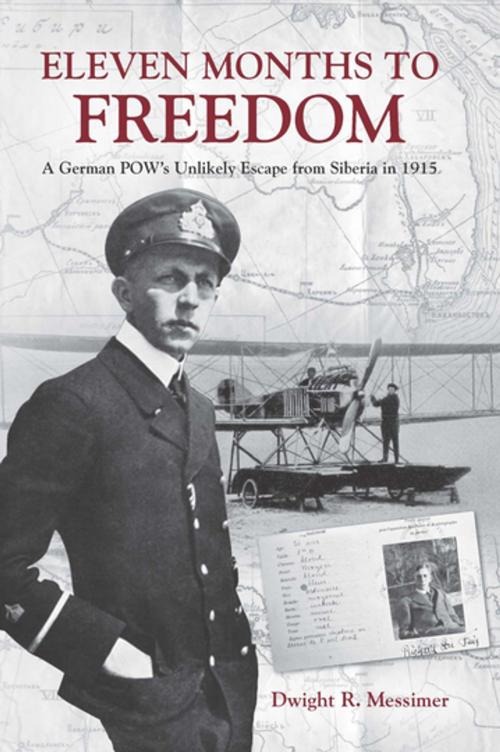Eleven Months to Freedom
A German POW's Unlikely Escape from Siberia in 1915
Nonfiction, History, Military, World War I| Author: | Dwight R. Messimer | ISBN: | 9781682470664 |
| Publisher: | Naval Institute Press | Publication: | November 15, 2016 |
| Imprint: | Naval Institute Press | Language: | English |
| Author: | Dwight R. Messimer |
| ISBN: | 9781682470664 |
| Publisher: | Naval Institute Press |
| Publication: | November 15, 2016 |
| Imprint: | Naval Institute Press |
| Language: | English |
Eleven Months to Freedom is about the wartime experience of a twenty-one year old German midshipman, Erich Killinger. When the German Navy’s officers’ school closed at the start of World War I Killinger, along with every man in his class, went to war as a midshipman. Killinger became an aerial observer on the Eastern Front where the Russians captured him and his pilot, Leutnant zur See Karl von Gorrissen, on 6 April 1915 after their Rumpler 4B-12 shed a propeller and crashed at sea off Libau.
Killinger’s time as a POW started off badly when he and von Gorrissen were accused of bombing a railway station in Libau that killed civilians, women and children. They had in fact not bombed the station, but the allegation stuck and the Russians sentence both men, without a trial, to life in the Sakhalin coal mines.
For nearly seven months, Killinger and several other POWs were transported on a slow-moving train across Russia from the Trubetskoy Bastion Prison in Saint Petersburg toward Vladivostok and the Sakhalin coal mines in Siberia. Having attempted to escape shortly after being captured, and bayonetted in the hand, Killinger was constantly looking for a way to escape. Along the way he and his fellow POWs were temporarily confined in two virtually escape-proof POW camps, which brought Killinger to the conclusion that an escape from the prison train offered the best chance for success.
The opportunity came on the night of 28 October 1915 when Killinger and four others dived window headfirst into the snow, and escaped into the night as the Russian guards fired wildly into the darkness. What followed was a brutal forty-five day trek in subzero temperatures during which they lacked proper clothing, and nearly starved. Bandits, Japanese, and Russian troops were a constant threat as well as internment by the Chinese.
After he entered the German-run escape pipeline in Mukden on 12 December 1915, Killinger passed through a series of German consulates and Etappendienst safe houses along the 800-mile route to Shanghai. German Consulates provided high quality identity papers, cover stories, and money. During his 16,000 plus miles trip from Shanghai to Skien, Norway, via the United States, Killinger spent his escape money lavishly, played the role of a French blade, enjoyed a shipboard romance, and traveled across the United States on the nation’s premier trains-the California Limited and the Twentieth Century Limited. He crossed the Atlantic as a deck hand on a three-island tramp that the British took into Stornoway for examination. There Killinger made a bold and risky move to avoid discovery and ultimately reached Skein, Norway safely. He arrived back in Germany on 6 March 1916-eleven months after being captured.
Killinger’s time as a POW started off badly when he and von Gorrissen were accused of bombing a railway station in Libau that killed civilians, women and children. They had in fact not bombed the station, but the allegation stuck and the Russians sentence both men, without a trial, to life in the Sakhalin coal mines.
For nearly seven months, Killinger and several other POWs were transported on a slow-moving train across Russia from the Trubetskoy Bastion Prison in Saint Petersburg toward Vladivostok and the Sakhalin coal mines in Siberia. Having attempted to escape shortly after being captured, and bayonetted in the hand, Killinger was constantly looking for a way to escape. Along the way he and his fellow POWs were temporarily confined in two virtually escape-proof POW camps, which brought Killinger to the conclusion that an escape from the prison train offered the best chance for success.
The opportunity came on the night of 28 October 1915 when Killinger and four others dived window headfirst into the snow, and escaped into the night as the Russian guards fired wildly into the darkness. What followed was a brutal forty-five day trek in subzero temperatures during which they lacked proper clothing, and nearly starved. Bandits, Japanese, and Russian troops were a constant threat as well as internment by the Chinese.
After he entered the German-run escape pipeline in Mukden on 12 December 1915, Killinger passed through a series of German consulates and Etappendienst safe houses along the 800-mile route to Shanghai. German Consulates provided high quality identity papers, cover stories, and money. During his 16,000 plus miles trip from Shanghai to Skien, Norway, via the United States, Killinger spent his escape money lavishly, played the role of a French blade, enjoyed a shipboard romance, and traveled across the United States on the nation’s premier trains-the California Limited and the Twentieth Century Limited. He crossed the Atlantic as a deck hand on a three-island tramp that the British took into Stornoway for examination. There Killinger made a bold and risky move to avoid discovery and ultimately reached Skein, Norway safely. He arrived back in Germany on 6 March 1916-eleven months after being captured.
Eleven Months to Freedom is about the wartime experience of a twenty-one year old German midshipman, Erich Killinger. When the German Navy’s officers’ school closed at the start of World War I Killinger, along with every man in his class, went to war as a midshipman. Killinger became an aerial observer on the Eastern Front where the Russians captured him and his pilot, Leutnant zur See Karl von Gorrissen, on 6 April 1915 after their Rumpler 4B-12 shed a propeller and crashed at sea off Libau.
Killinger’s time as a POW started off badly when he and von Gorrissen were accused of bombing a railway station in Libau that killed civilians, women and children. They had in fact not bombed the station, but the allegation stuck and the Russians sentence both men, without a trial, to life in the Sakhalin coal mines.
For nearly seven months, Killinger and several other POWs were transported on a slow-moving train across Russia from the Trubetskoy Bastion Prison in Saint Petersburg toward Vladivostok and the Sakhalin coal mines in Siberia. Having attempted to escape shortly after being captured, and bayonetted in the hand, Killinger was constantly looking for a way to escape. Along the way he and his fellow POWs were temporarily confined in two virtually escape-proof POW camps, which brought Killinger to the conclusion that an escape from the prison train offered the best chance for success.
The opportunity came on the night of 28 October 1915 when Killinger and four others dived window headfirst into the snow, and escaped into the night as the Russian guards fired wildly into the darkness. What followed was a brutal forty-five day trek in subzero temperatures during which they lacked proper clothing, and nearly starved. Bandits, Japanese, and Russian troops were a constant threat as well as internment by the Chinese.
After he entered the German-run escape pipeline in Mukden on 12 December 1915, Killinger passed through a series of German consulates and Etappendienst safe houses along the 800-mile route to Shanghai. German Consulates provided high quality identity papers, cover stories, and money. During his 16,000 plus miles trip from Shanghai to Skien, Norway, via the United States, Killinger spent his escape money lavishly, played the role of a French blade, enjoyed a shipboard romance, and traveled across the United States on the nation’s premier trains-the California Limited and the Twentieth Century Limited. He crossed the Atlantic as a deck hand on a three-island tramp that the British took into Stornoway for examination. There Killinger made a bold and risky move to avoid discovery and ultimately reached Skein, Norway safely. He arrived back in Germany on 6 March 1916-eleven months after being captured.
Killinger’s time as a POW started off badly when he and von Gorrissen were accused of bombing a railway station in Libau that killed civilians, women and children. They had in fact not bombed the station, but the allegation stuck and the Russians sentence both men, without a trial, to life in the Sakhalin coal mines.
For nearly seven months, Killinger and several other POWs were transported on a slow-moving train across Russia from the Trubetskoy Bastion Prison in Saint Petersburg toward Vladivostok and the Sakhalin coal mines in Siberia. Having attempted to escape shortly after being captured, and bayonetted in the hand, Killinger was constantly looking for a way to escape. Along the way he and his fellow POWs were temporarily confined in two virtually escape-proof POW camps, which brought Killinger to the conclusion that an escape from the prison train offered the best chance for success.
The opportunity came on the night of 28 October 1915 when Killinger and four others dived window headfirst into the snow, and escaped into the night as the Russian guards fired wildly into the darkness. What followed was a brutal forty-five day trek in subzero temperatures during which they lacked proper clothing, and nearly starved. Bandits, Japanese, and Russian troops were a constant threat as well as internment by the Chinese.
After he entered the German-run escape pipeline in Mukden on 12 December 1915, Killinger passed through a series of German consulates and Etappendienst safe houses along the 800-mile route to Shanghai. German Consulates provided high quality identity papers, cover stories, and money. During his 16,000 plus miles trip from Shanghai to Skien, Norway, via the United States, Killinger spent his escape money lavishly, played the role of a French blade, enjoyed a shipboard romance, and traveled across the United States on the nation’s premier trains-the California Limited and the Twentieth Century Limited. He crossed the Atlantic as a deck hand on a three-island tramp that the British took into Stornoway for examination. There Killinger made a bold and risky move to avoid discovery and ultimately reached Skein, Norway safely. He arrived back in Germany on 6 March 1916-eleven months after being captured.















